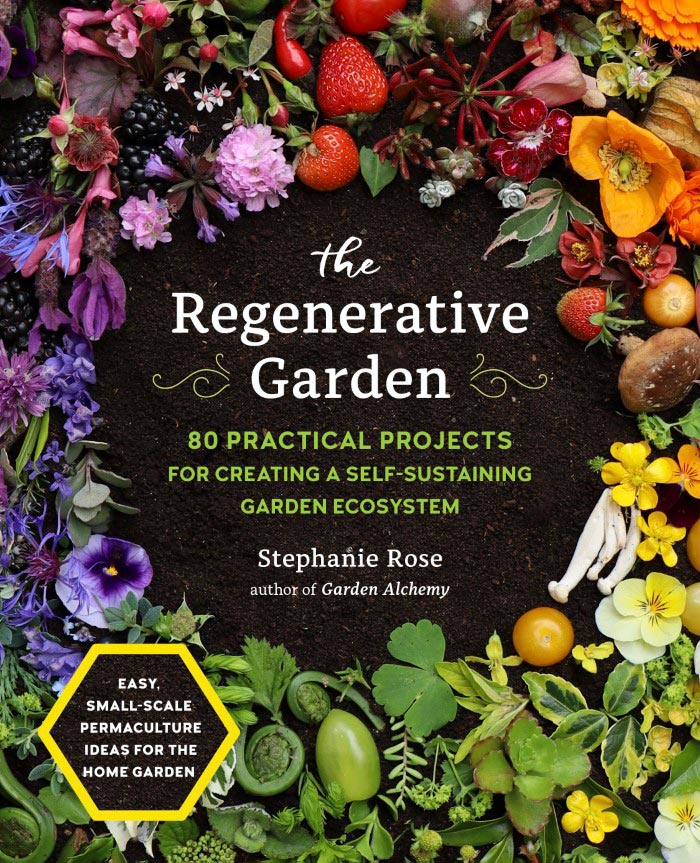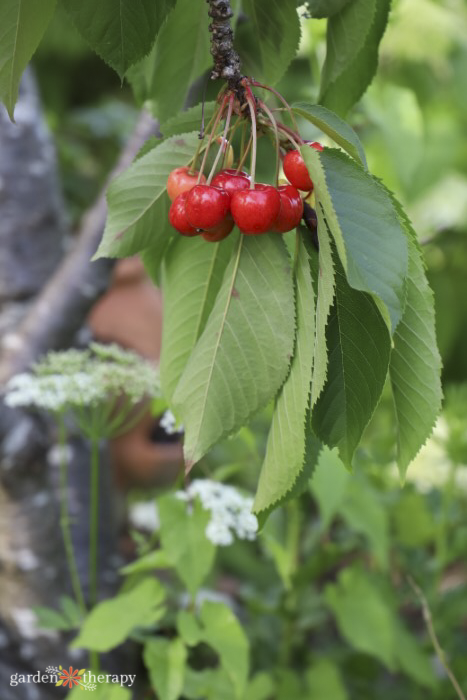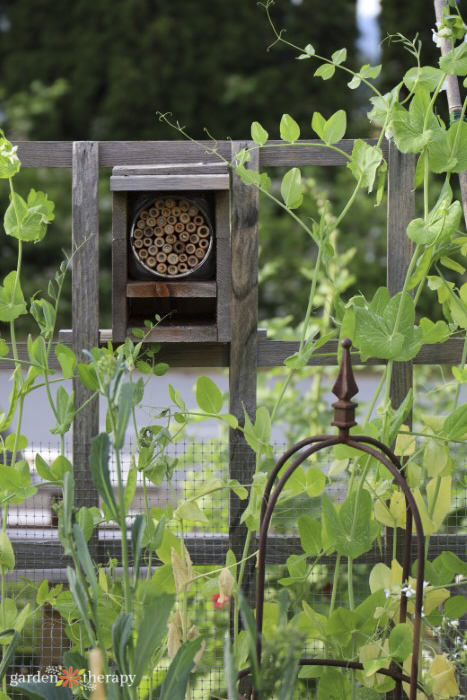Ditch the vegetable garden and redesign your food garden as a forest! Food forests are a traditional but seriously cool practice of growing your own self-reliant mini forests that produce tons of food. This guide covers all the layers of the food forest and how you can start designing your own edible forest garden.

Until recently, biologists saw ancient pockets of food forests that exist within tropical rainforests as accidental. But, increasing evidence shows these forest gardens as a result of deliberate cultivation by Indigenous Peoples.
These forest gardens are filled with a variety of food, layered, interconnected, and self-sustaining. In my home province of British Columbia, evidence shows there were food forests planted more than 150 years ago!
Today, you can still plant these amazing self-reliant ecosystems right in your backyard. This guide covers all the tips to start planning your epic food forest.

This post will cover…
- What is a Food Forest?
- Food Forest Benefits
- How to Start a Food Forest
- Food Forest Layers
- Overstory Trees
- Understory Trees
- Shrub and Bushes
- Epiphytes
- Vining Plants
- Herbaceous Plants
- Mushrooms
- Groundcovers
- Root Plants
- More Natural Ways to Sustain Your Garden
This food forest is one of the many self-reliant garden projects you’ll find in my book The Regenerative Garden. If you’re looking for more ideas on how to flip the traditional garden up on its head in lieu of more sustainable spaces, be sure to check it out!

What is a Food Forest?
Food forests consist of a host of beneficial plants carefully selected and arranged to mimic a natural forest system. Together, they boost each other up creating a self-sustaining mini-ecosystem designed to give you plenty of food and materials.
There are many similarities between a food forest and a guild. The plants in a food forest make up several guilds all working together to support and feed one another in many different ways.
People often use the words “guilds” and “food forests” interchangeably. However, a food forest’s design specifically produces the highest amount of consumable by-products such as food, medicine, and craft materials in a small footprint.
Of course, food forests also build soil and attract pollinators, creating a cohesive ecosystem that is regenerative and long-lasting without the need for human effort to maintain it.

Food Forest Benefits
A food forest is not just efficient use of space to grow food but it is also a fully self-sustaining ecosystem. Once planted, gardeners can walk away from a food forest for many years only to return and find it flourishing with a large amount of food. Especially when you compare it to a traditional vegetable garden!
Food forests can be grown in many climates, including dry lands, the tropics, temperate climates, and more forested regions. You can customize them exactly to your microclimate to get an abundant harvest over a long period of time.
Food forests are also incredibly low maintenance. There’s no need for extra fertilizer, as the natural mulch from the trees and plants recycles nutrients. Since perennials tend to have deeper root systems, there is little need for watering.
These perennials also protect the soil. Since there’s no need to dig after initially planting, the soil structure and vast soil ecosystem below remain undisturbed and allowed to flourish.

How to Start a Food Forest
Food forests are an ecological community all working together to support one another to grow and thrive. This type of ecosystem thrives with biodiversity, including plants, animals, and insects. The plants in the food forest are characterized by the layers in which they are growing.
The plant choice is completely dependent on your climate, type of soil, and amount of sunlight and water. Some food forests are only native plants while others incorporate non-native and even exotic plants.
Always think big picture when planning your food forest. Try to make the space as open as possible, allowing for not only shade but dappled shade and sunny areas. Your food forest can be as large or as small as you like.
Think beyond what’s immediately visible. A major part of the food forest is the soil itself. Prior to planting, ensure the soil has everything it needs.
You’ll also need to support wildlife as well. In the food forest, wildlife can keep out the bad bugs and assist with pollinating.

Food Forest Layers
What exactly is in a food forest? There are many layers to growing an edible forest garden to efficiently use up the space and produce as many useful materials as possible. Listing them from sky to soil, here are the components that make up the structure of a food forest.
Overstory Trees
The overstory is made up of the large foundation trees around which the food forest is based. The size of an overstory tree is what sets the overall footprint of the food forest. Majestic, 100-foot-tall trees create a wide footprint for planting, while smaller fruit trees that reach 25-30 feet can be planted in groups.
Keep in mind that the tallest canopy trees can be difficult to harvest properly. Much of the food grown will feed wildlife or turn into compost. When the tree reaches maturity, it will still provide plenty to eat as well.

Understory Trees
Understory trees grow shorter and tolerate a little bit of shade beneath the overstory trees. Typically, these are native trees, such as dogwood and redbud, or ones that tolerate shade such as filbert and pawpaw.
These trees can also be planted with succession in mind as they are ones that leaf and fruit earlier to take advantage of the sun before the overstory trees create shade.

Shrub and Bushes
The shrub layer consists of perennials that have multiple woody stems that generally grow about 2-12 feet high. These are often berry plants that also provide wildlife habitat and wind protection.

Epiphytes
Epiphytes are not usually included as a layer in traditional food for people. However, they do provide food sources for humans. An epiphyte is a plant that doesn’t grow in soil but instead attaches itself to the surface of another plant and gets its nutrients and water from the air.
Moss and lichen are examples of epiphytes that grow well in shade and provide an important food source for wildlife. They also contribute to the biomass of the soil as they fall and decompose. Fallen lichen such as usnea can be harvested as a medicinal herb.
Vining Plants
Climbing plants such as vines and bines are a way to take advantage of the vertical space of a garden to produce more food products. Some annuals (such as beans) produce lots of food and naturally die back after food production. Other plants (such as hops) are also productive, but they can easily take over if not properly managed.

Herbaceous Plants
The herbaceous layer below the woody layer is filled with annual, biennial, and perennial plants. They’re either self-seeded or grow back from their roots but, either way, they die back each year.
Herbaceous plants vary in their sun and shade needs so plant the sun-lovers on the sunny side of the food forests and the shade-lovers on the shadier sides. This layer is essential for food production as well as for creating organic mater that mulches and feeds the soil.

Mushrooms
Another layer not typically included in traditional seven-layer food forests is mushrooms. However, both nutritional and medicinal fungi grow well in forest environments. Introducing mushrooms into your food forest is a great way to include another layer of consumables that will greatly benefit the entire ecosystem.

Groundcovers
The groundcover layer consists of herbaceous annuals, perennials, and biennials that grow low to the ground (such as strawberries, chickweed, clover, and herbs) but can also include ground vines (such as squash and sweet potatoes).

Root Plants
Root plants allow us to improve soil structure by aerating the soil but also to grow nutritious food crops just below the soil’s surface.
And that wraps up all the layers of the food forest! Now you can start planning your own using plants that uniquely fit your space. Let me know in the comments below how your edible forest garden turns out.





Great suggestions on the layers in the food forest here Stephanie!
I featured it here so more people hopefully take the time to read it; https://www.veg-geek.com/newsletters/17082022